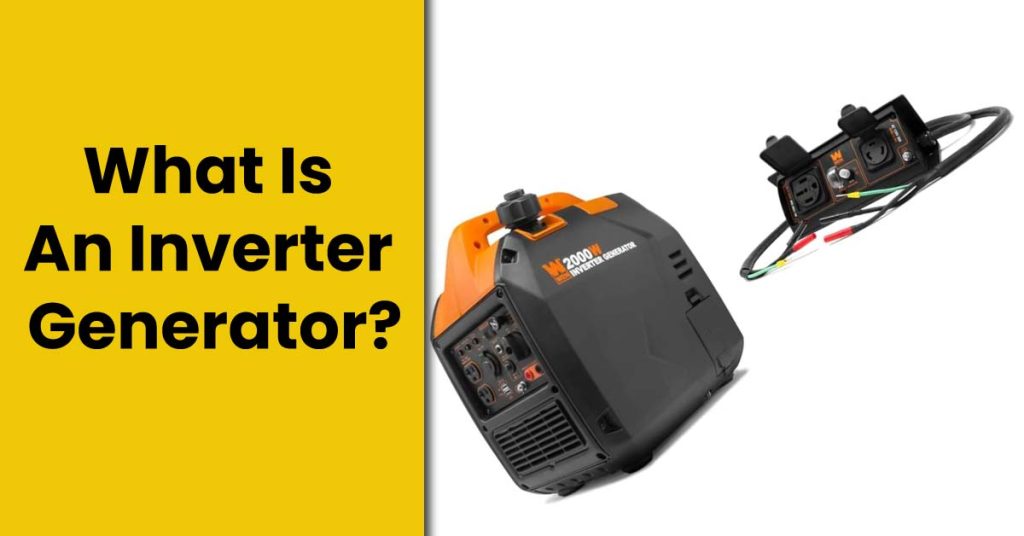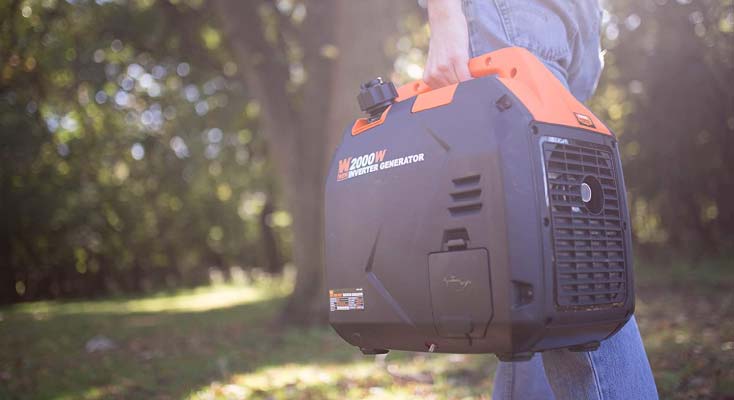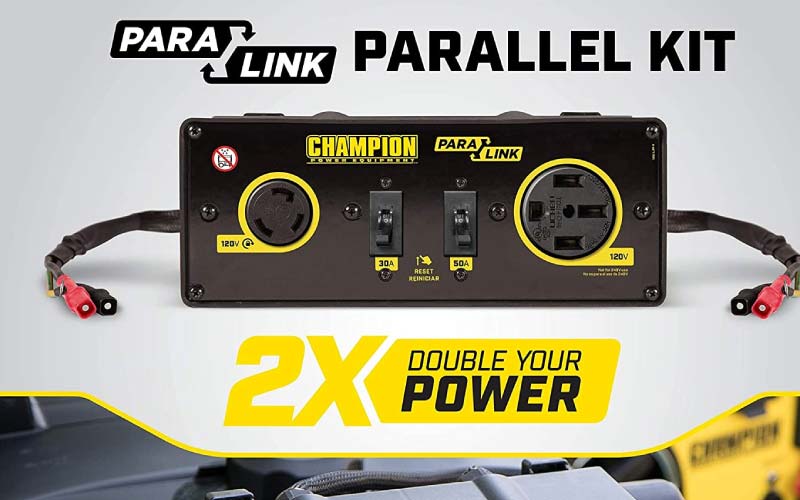What Is An Inverter Generator? – Its Working & Pros, Cons
In this article, I have explained “what is an inverter generator”, how it works, pros & cons, and how to choose one.
Mostly when people talk about using a generator to power their appliances, they are actually talking about a conventional generator.
You may have an idea about them being heavy and loud gas guzzlers. How amazing it’d be for you if we reveal a secret about another type of generator that runs quietly, is easy to carry, and uses very low fuel?
No doubt, conventional generators are popular due to their different capabilities, but an inverter generator can be a perfect choice for many people to generate power when needed.
If you want to use a generator for smaller and personal electronic devices, then these clean-running inverter generators are ideally a must.
Honda introduced the first-ever inverter generator in 1987 named Honda EX300. Since then, inverter technology has advanced to greater heights.
Before jumping into the details, let’s find out what is an inverter generator and how it will be beneficial for you.
An inverter generator is a new type of portable generator with some electronic upgrading. The engine of an inverter generator automatically adjusts its speed to the electrical demand, instead of running at a constant speed without noticing the size of the load. This immensely reduces fuel consumption and also the noise level.
What Is An Inverter Generator?
An inverter generator is a machine that inverts electricity to provide safer, cleaner, and more stable power to sensitive electronics. The engine throttles up and down to meet the energy demand instead of going full tilt all the time. Inverter generators are quieter, energy-efficient, compact, and consume less fuel compared to traditional generators.
How Does An Inverter Generator Work?

- An inverter generator’s work is to convert AC (alternating current) power produced by the machine into the DC (Direct current).
- The first AC power produced by the generator is not a pure sine wave and it is not stable. So to smooth it out, the inverter in the generator converts DC power back to AC power rating at the standard power rate of 120V and 60Hz.
- The final AC power produced is much more stable and smooth with a steady sine wave.
- The harmonic distortion of final AC power will be less and can be safely used for power-sensitive devices like cellphones, laptops, coffee makers, cameras, and medical equipment.
A non-inverter generator creates something called dirty power which is usually power with voltage spikes harming the sensitive electronic equipment.
There is a high total harmonic distortion that represents a variance from the standard 60Hz frequency. It shows that if you plug your computer into the regular open-frame generator, some operating errors or computer memory loss will occur due to power fluctuations.
While an inverter generator clears up the power by inverting those electrical waves in such a way to allow a consistent flow of electricity without any irregularity or ripples due to dirty power.
How Are Inverter Generators Different From Conventional Generators?
A non-inverter generator or a conventional generator produces directly AC electric current while an inverter generator produces AC electric current then converts it into DC electric current and again converts it back to AC electric current. Many other features differentiate between conventional and inverter generators.
Portability:

A conventional generator uses a lot more fuel and also requires larger tanks with wheeled and handled designs for mobility. While inverter generators are much more fuel-efficient and require smaller tanks, they are often more portable and weigh usually less than 100 pounds. Most of the models come in handheld designs that are easily transportable and even hooked up with car batteries.
The portability of these types of generators comes from the size and power output that are often associated but inverter generators do not provide as much power as traditional conventional generators.
Fuel Efficiency:
No doubt, the inverter generators are also fuel-efficient which makes them better for the environment as well as easier on your wallet.
Current:
Another significant difference between these two generators is the kind of electricity they produce. A conventional generator can never produce clean electricity which means they are not the best choice for sensitive devices such as personal electronics. While an inverter generator can produce a steady sine wave of electricity and low harmonic distortion required for those appliances or devices.
If a generator is being used to power devices during a power breakdown or on a camping trip, there will definitely be a need for clean electricity.
Power:
A conventional generator can produce more power with the help of a large tank while a similar run time is offered by smaller tanks of inverter generators due to their energy efficiency.
The difference in size shows that a conventional generator will offer large power outputs that can reach wattages as high as 10,000 watts. While inverter generators usually max out at 6000 to 7000 watts. For high-powered uses, a conventional generator is usually the best option.
Noise:
One major downside of a conventional generator is noise. When a 65-decibel engine runs outside a campsite, it will ruin a serene, or natural gateway in no time. It will also create anger in your neighbors if that generator is being used at home. While inverter generators run much quieter due to their steady and consistent RPM.
Parallel Connections:

The ability to link up multiple inverter generators of similar types in order to deliver double power is referred to as a parallel connection. As an inverter generator offers less power output, it is a great way to get more power when needed.
On the other hand, a conventional generator does not offer this feature.
Emissions:
It is important to meet your state and local emission requirements if you are using a conventional generator. Some states require additional approvals while the inverter generators cause fewer emissions which makes them easier to find one that meets the requirements of the environment. Also, the fuel efficiency makes them more eco-friendly.
Price:
No doubt, conventional generators are popular due to their massive availability in the past, which is why many generators have been produced with cheaper qualities.
The inverter generators have a more complex design and are a bit more expensive but these generators are worth the cost of what you look for.
How To Size An Inverter Generator?
The size of the inverter generator will depend on the devices you need to power. Just examine the setup carefully and take the stock of each device you want to plug in.
If you want to use the generator for powering the backup of the whole home, you’ll need to consider whether you are planning to plug in large items like a fridge, heater, sump pump, or smaller devices such as phones, and computers, laptops, TV, or lights. Enlist all the devices and also jot down the wattage requirements for each device. You will need to remember the running and starting watts.
After collecting all the necessary information add the all wattages together. Add almost 50% more than what you have calculated as different situations will require different generator sizes but having a stock will prove a great source of guidelines.
In order to work with small items such as lights, phones, or laptops during the power breakdown, you will get less than 1kW. By plugging in more items, the need will also go up. For a small TV or a heater, there will be the need for 2000 watts.
however, for larger appliances, the wattage requirement will exceed 3000 to 4,000 watts or even higher.
Calculation of power is necessary as it will help to provide power on hand rather than to come up short.
You can Follow our detailed Guide to for generator sizing;
How To Choose An Inverter Generator
There is a need to determine two things before choosing the right inverter generator:
- For what purposes do you want to purchase it?
- How much power you will require for appliances?
If you want to power up the whole home for backup during a breakdown or storm then an inverter won’t be a good option to go for. For this purpose, you will need a larger and emergency portable generator. For powering a few basic devices, you can confidently rely on a larger inverter generator.
An inverter generator is also best for recreational activities and it is more convenient to use for tailgating parties and camping.
Advantages of Inverter Generators
Easy Maintenance: Inverter generators require very little maintenance as compared to their conventional counterparts. The only maintenance required is with regards to battery inspection which should always be performed each month for the surety of smooth operation.
Cleaner Power: The electronic technology of the inverter produces a sine wave that outputs low fuel emission and also provides cleaner power as compared to traditional generators. Having higher quality electrical outputs mean the environment is safer for those electronics. The output quality also lends to ensuring parallel capability.
Low Noise Level: An inverter generator produces noise at less than 60 decibels of frequency that is almost equal to the volume of a quiet conversation. A smaller engine works at a slower and steadier pace that produces less noise contrasted to a conventional generator.
These generators are constructed with a noise-reducing design that has an enclosed casing and installed mufflers for the insulation of sound.
Fuel Efficiency: The fuel efficiency of inverter generators is much better than a conventional fuel-powered generator. The inverter generator is capable of adjusting the speed of the engine automatically to only what is needed by the load while the conventional generator operates at a constant speed. When a generator will operate at a slow speed it will save energy as well as less fuel will be used during the operation.
Portability: Inverter generators are lighter in weight than standard fuel-based generators due to their smaller fuel tanks. For easy mobility, they have carrying handles and wheels constructed in their design.
Checkout our guide about the smallest portable generators
Disadvantages Of Inverter Generators
Lower Power Output: The one downside of inverter generators is they are not as powerful as conventional generators are, with reference to output ranging from mid to low thousands of watts. A standard inverter generator can run some small household appliances and outdoor equipment. But to increase the power output, an inverter generator can run in parallel mode with a duplicate generator.
Cost: Inverter generators are much more expensive than conventional generators. The upfront costs can be hefty but the unit provides plenty of other benefits that make the investment worthwhile in different circumstances.
Is An Inverter Generator Worth It?
Undoubtedly, inverter generators are convenient, and fuel-efficient to power up sensitive electronics during power outages.
Most people find higher upfront costs are due to fuel savings, portability, and quiet operation. If power breakdown is frequent in your area, while looking for heavy power backup, you should go for portable or standby generators.
But in case to power up smaller devices in minor power outages, nothing can beat the performance and functioning of an inverter generator and it will be well worth it.

Alex Black is a seasoned electrical engineer with a remarkable 8-year track record specializing in appliances, generators, and transfer switches. With extensive hands-on experience in the field, Alex possesses a deep understanding of electrical systems and their intricate workings. Throughout their career, Alex has consistently demonstrated expertise in designing, troubleshooting, and maintaining various electrical appliances.
